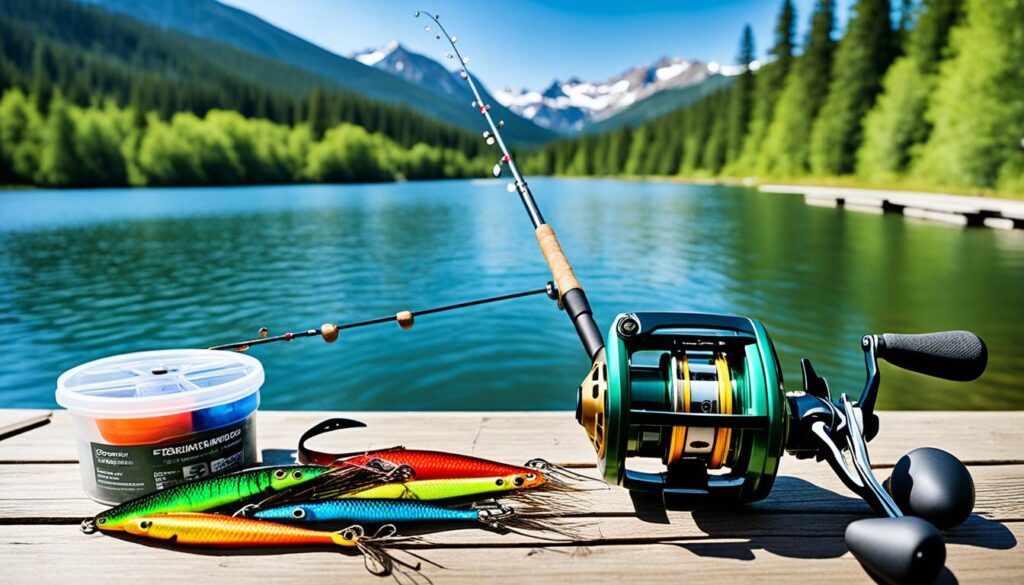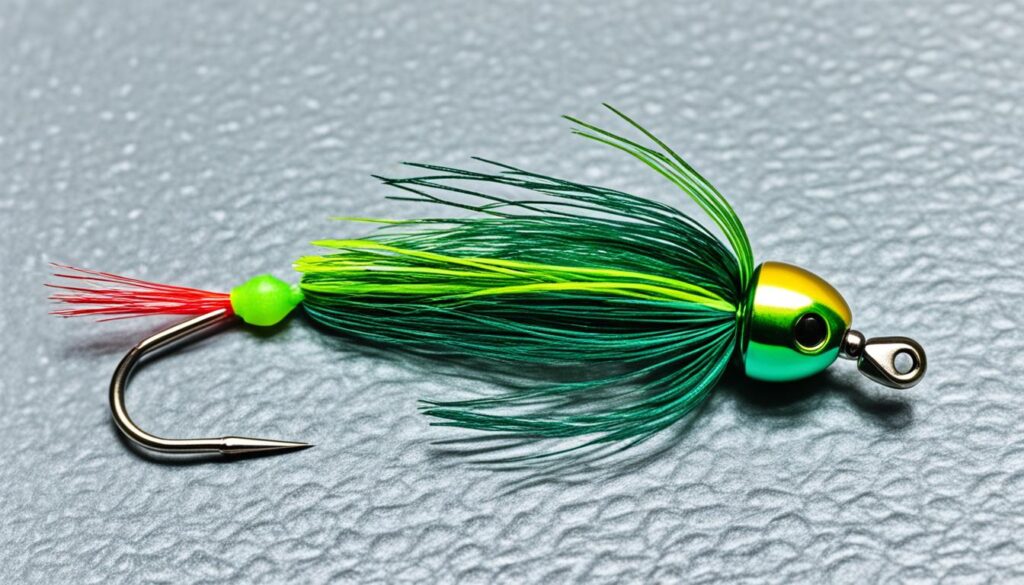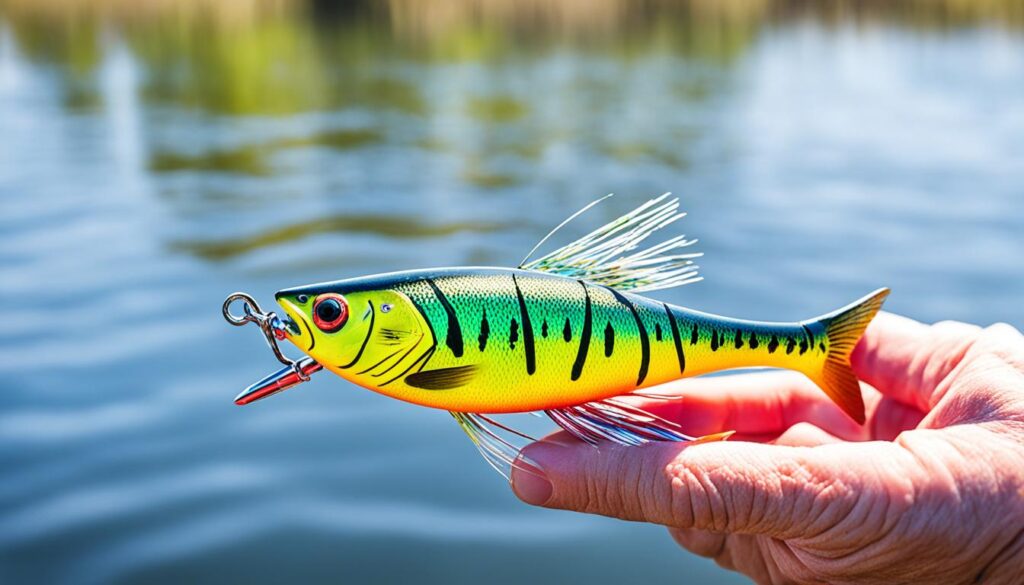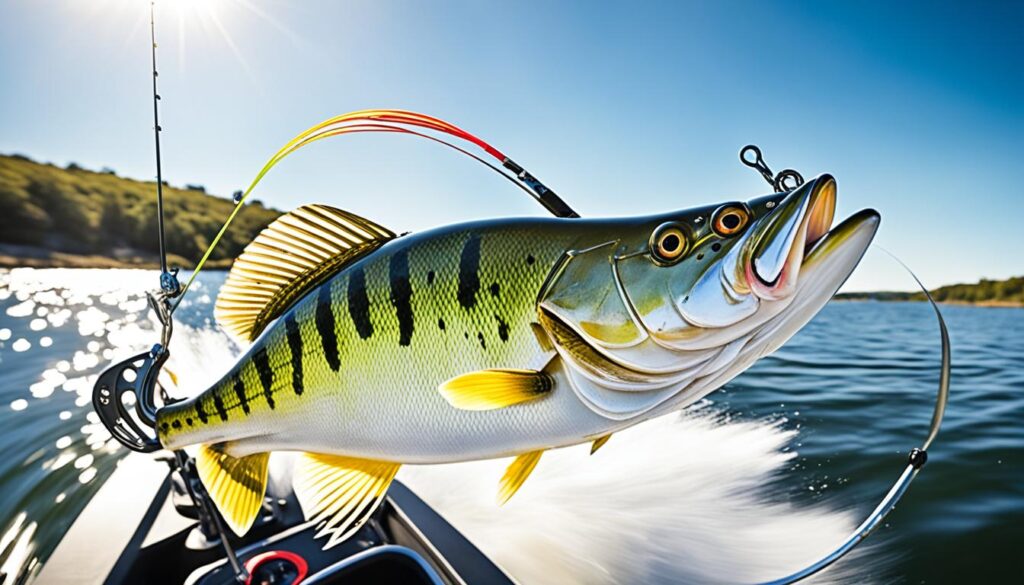When it comes to bass fishing, having the right gear and techniques can make all the difference between a successful day on the water and going home empty-handed. One highly effective lure that every angler should have in their tackle box is the wobble head jig. This versatile fishing lure is specifically designed to attract bass both inshore and offshore, making it a must-have for any avid angler.
The wobble head jig features a unique design and action that mimics the movement of natural prey, making it irresistible to bass. Whether you’re fishing in thick cover or open water, this jig can entice even the most finicky bass to bite. However, mastering the techniques and using the right gear are essential for maximizing your success.
Key Takeaways:
- Wobble head jigs are versatile fishing lures that can attract bass in a variety of fishing conditions.
- There are different types of wobble head jigs available, each designed for specific fishing conditions and techniques.
- Choosing the right wobble head jig techniques and understanding the behavior of summer bass can greatly increase your chances of success.
- Having the right gear, including a heavy-action rod, baitcasting reel, and a variety of fishing lures, is essential for wobble head jig fishing.
- Experimenting with different presentations and colors can help you find the most effective approach for the specific fishing environment.
The Different Types of Wobble Head Jigs
When it comes to freshwater fishing jigs, there is a wide variety of options available, each designed for specific fishing conditions and techniques. Understanding the different types of wobble head jigs can greatly enhance your jig fishing techniques and improve your chances of success.
Here are some popular types of freshwater fishing jigs:
- Round Head Jigs: These jigs have a round-shaped head and are suitable for a variety of fishing environments.
- Soccer Jigs: Designed with a tapered head, soccer jigs are ideal for fishing in rocky areas or heavy cover.
- Swim Jigs: These jigs have a streamlined design and are great for imitating the movement of baitfish.
- Finesse Jigs: These smaller-sized jigs are perfect for targeting finicky fish or when finesse fishing techniques are required.
- Flipping Jigs: With their weedless design, flipping jigs are excellent for fishing in heavy cover and vegetation.
- Arkie Jigs: Arkie jigs feature an arched head and are effective when fishing around structure or in currents.
- Hair Jigs: These jigs have a hair skirt and are known for their lifelike action, making them irresistible to fish.
- Shaky Head Jigs: Shaky head jigs have a stand-up design that creates a tantalizing action when sitting on the bottom.
- Ned Rig Jigs: Ned rig jigs are small, finesse-style jigs that mimic natural prey and are perfect for clear water conditions.
- Tube Jigs: Tube jigs are hollow and can be filled with scent or bait, making them an excellent choice for targeting a variety of species.
- Grass Jigs: Designed with a weed guard, grass jigs are ideal for fishing in dense vegetation or weed beds.
- Stand-up Jigs: Stand-up jigs have a flat bottom and are great for imitating a feeding crayfish or baitfish.
- Wobble Jigs: Wobble jigs have a wobbling action that attracts fish and can be used in a variety of fishing environments.
- Chatterbaits: These jigs have a vibrating blade that creates a unique action, making them highly effective for attracting fish.
- Punch Jigs: Designed with a heavy weight, punch jigs are used for punching through heavy cover and vegetation.
Each type of jig has its own strengths and applications, so it is important to choose the right one for your specific fishing needs. Experimenting with different types and sizes of jigs can help you discover the most effective jig fishing techniques for your favorite fishing spots.
Now that we have explored the different types of wobble head jigs, let’s move on to the next section where we will discuss the best jig fishing techniques to use with them.
Choosing the Right Wobble Head Jig Techniques
When it comes to fishing with wobble head jigs, there are several techniques that can greatly increase your chances of success. Here are some popular wobble head jig fishing tips and techniques to help you catch more summer bass:
- Flipping and pitching: This technique involves making short, targeted casts to specific areas with heavy vegetation or cover. It allows you to present the wobble head jig accurately, enticing bass hiding in dense cover to strike.
- Casting to isolated cover: Bass often seek shelter in isolated cover such as fallen trees, docks, or submerged structures. By casting your wobble head jig near these areas, you can tempt the bass into biting as they seek out potential prey.
- Fishing contours: Bass frequently relate to depth changes, underwater structures, and contour lines. By casting your wobble head jig along these contour lines, you can effectively target bass positioned near drop-offs, points, or ledges.
- Using scent: Adding scent to your wobble head jig can help attract additional attention from curious bass. Consider using scented soft plastics or spray-on scents that mimic the natural scent of prey fish or crayfish.
- Targeting specific seasonal patterns: Bass behavior can change throughout the summer, so it’s crucial to adapt your wobble head jig techniques accordingly. Pay attention to seasonal patterns, such as bass congregating near spawning areas during the pre-spawn or feeding in deeper water when temperatures rise.
By mastering these wobble head jig techniques and understanding when and where to use them, you can strategically target and catch more summer bass. Experiment with different techniques and pay attention to the feedback from the fish to fine-tune your approach. With persistence and practice, you’ll become a skilled angler in no time!
Essential Gear for Wobble Head Jig Fishing

To maximize your success with wobble head jig fishing, it is important to have the right gear. Here are the essential items you need in your tackle box:
| Item | Description |
|---|---|
| Heavy-Action Rod | A sturdy rod with a heavy power rating is ideal for wobble head jig fishing. It provides the strength and sensitivity needed to handle the powerful strikes of bass. |
| Baitcasting Reel | A baitcasting reel offers better control, accuracy, and casting distance, making it the preferred choice for wobble head jig fishing. |
| Heavy-Duty Braided Line | Braided line has low stretch, high strength, and excellent sensitivity, allowing you to detect even the subtlest of bass bites when fishing with wobble head jigs. |
| Jig Heads | Choose jig heads of different weights to match the water depth and the size of the wobble head jig you are using. Opt for quality jig heads that are durable and have sharp hooks. |
| Freshwater Fishing Lures | Stock up on a variety of freshwater fishing lures that are known to attract bass. Include soft plastic crawfish imitations, shad-imitating swimbaits, and creature baits in your arsenal. |
| Scent, Tackle Boxes, and Fishing Pliers | Enhance your fishing experience by using scent attractants to entice bass towards your wobble head jig. Keep your gear organized and easily accessible with tackle boxes. Fishing pliers are essential for removing hooks and handling fish safely. |
Investing in high-quality gear that is specifically designed for wobble head jig fishing will not only improve your chances of catching more bass but also ensure that you have a more enjoyable time on the water.
Tips for Using Wobble Head Jigs in Different Fishing Environments
When it comes to using wobble head jigs, the fishing environment plays a crucial role in determining your success. Different factors such as water clarity and fish behavior can influence your choice of jig color, size, and presentation. Let’s explore some tips to help you maximize your results in various fishing environments.
1. Water Clarity and Jig Colors
In clear water, bass tend to have better visibility and are more cautious. Using natural and subtle colors for your wobble head jigs can be highly effective in these conditions. Earthy tones, greens, and browns can mimic the appearance of natural baitfish and crawfish, enticing bass to strike.
On the other hand, in murky or stained water, the visibility is reduced, and bass rely more on their lateral line and vibration senses to locate prey. This is where brighter and more contrasting colors, such as chartreuse, orange, and black, can grab their attention and trigger strikes.
Remember to take into account the water clarity when selecting the color of your wobble head jig. Adapting to the conditions will significantly increase your chances of success.
2. Adjusting Jig Weight and Presentation
Another important factor to consider is the depth of the water. Bass tend to hold at different depths depending on the time of day, water temperature, and available cover. To effectively target them, you’ll need to adjust the weight of your wobble head jig and your presentation technique.
In shallow water, opt for lighter jig weights to avoid spooking the bass. A finesse presentation, such as a slow drag or hop, can be highly effective in enticing strikes. As the water gets deeper, gradually increase the jig weight to reach the desired depth and maintain good bottom contact.
Experimenting with different jig weights and presentations will help you find the most effective approach for the specific fishing environment you’re in.
3. Size Matters
Matching the size of your wobble head jig to the available forage is crucial for getting bass to strike. Take note of the size of the baitfish in the area and choose a jig that closely resembles their size. This will make your presentation more convincing and increase your chances of enticing a bite.
Additionally, consider the size and aggression of the bass you’re targeting. In lakes known for producing larger bass, using bigger jigs can help you weed out smaller fish and specifically target trophy-sized bass.
4. Be Versatile and Experiment
Every fishing environment is unique, and what works in one location may not work in another. The key to success with wobble head jigs is to be versatile and willing to experiment with different colors, sizes, and techniques.
Keep track of what works and what doesn’t, and gradually develop your own playbook of successful strategies for different fishing environments. The more you fish with wobble head jigs, the better you’ll become at reading the conditions and making the necessary adjustments to maximize your success.
Remember, bass can be unpredictable, and what works on one day may not work on another. So be open to trying new approaches and adapting your tactics as needed.
| Water Clarity | Recommended Jig Colors |
|---|---|
| Clear Water | Natural and Subtle Colors |
| Murky/Stained Water | Bright and Contrasting Colors |
Note: Adjust the table according to the number of rows and columns required for an informative and visually appealing presentation.
By considering the fishing environment, adjusting your jig colors and sizes, and being willing to experiment, you will optimize your use of wobble head jigs and increase your chances of catching more bass in different fishing environments.
Understanding the Behavior of Summer Bass
To effectively catch summer bass with wobble head jigs, it is important to understand their behavior during this season. Summer bass tend to be more active, feeding on various prey like crayfish, baitfish, and insects. They can be found in a variety of habitats, including shallow cover, deep water structure, and open water. By understanding their behavior and preferred prey, you can tailor your wobble head jig presentations to mimic their natural food sources and increase your chances of getting a bite.
| Fish Behavior | Preferred Prey | Habitat |
|---|---|---|
| Active feeding | Crayfish, baitfish, insects | Shallow cover, deep water structure, open water |
Fish Behavior:
Summer bass are more active during this season, as they feed on crayfish, baitfish, and insects.
Preferred Prey:
Crucial to the bass diet during summer are crayfish, baitfish, and insects.
Habitat:
You can find summer bass in various habitats, such as shallow cover, deep water structure, and open water.
Choosing the Right Wobble Head Jig Size and Weight

The size and weight of your wobble head jig are critical factors in enticing bass to strike. To optimize your chances of success, consider the depth of the water, the size of the baitfish in the area, and the behavior of the bass when selecting the appropriate jig size and weight. Having a variety of sizes and weights in your tackle box allows you to experiment and find the perfect combination that attracts the attention of bass.
When fishing in shallow waters, a lighter jig can be more effective as it allows for a more natural presentation and slower sinking action. On the other hand, deeper waters may require heavier jigs to reach the desired depth quickly and maintain better contact with the bottom. Keep in mind that the weight of the jig should be proportional to the current and wind conditions to ensure proper control and presentation.
Consider the size of the baitfish in the area as bass often feed on prey of similar proportions. Matching your wobble head jig to the size of the baitfish can increase its appeal and make it appear more natural. Additionally, observing the behavior of the bass can provide valuable insights into their feeding patterns and preferences. Depending on their activity level, you may need to adjust your jig size and weight to entice a reaction bite or provoke a predatory response.
Wobble Head Jig Size and Weight Guidelines
| Water Depth | Suggested Jig Size | Suggested Jig Weight |
|---|---|---|
| 0-5 feet | 1/8 – 1/4 ounce | Extra Light – Light |
| 5-10 feet | 1/4 – 3/8 ounce | Light – Medium |
| 10-20 feet | 3/8 – 1/2 ounce | Medium |
| 20+ feet | 1/2 – 1-ounce | Medium – Heavy |
These guidelines can serve as a starting point to help you choose the appropriate size and weight for your wobble head jig. However, it’s essential to experiment and adjust based on the specific fishing conditions, the behavior of the bass, and your personal preferences. By fine-tuning your selection, you can enhance your chances of triggering the strike and landing more bass.
Tips for Presentation and Retrieval of Wobble Head Jigs

When it comes to wobble head jig fishing, how you present and retrieve your lure can make all the difference in catching bass. Here are some important tips to keep in mind:
- Make accurate casts: Casting accuracy is crucial when using wobble head jigs. Aim for specific targets, such as submerged structure, weed edges, or drop-offs, where bass are likely to be hiding. Practice your casting technique to hit your desired spot consistently.
- Target specific areas: Bass can be selective about where they feed, so it’s important to focus on key areas. Look for underwater cover, such as fallen trees, rocks, or vegetation, as bass are more likely to strike when they have a place to ambush their prey.
- Vary your retrieve speed and cadence: The movement of a wobble head jig should mimic the behavior of natural prey. Experiment with different retrieve speeds and cadences, including fast twitches, pauses, and slow retrieves, to trigger a bass’s feeding instinct. Pay attention to how the fish respond and adjust your retrieve accordingly.
- Try different presentations: Wobble head jigs can be presented in various ways to entice bass to strike. Popular techniques include hopping the jig along the bottom, dragging it slowly to mimic a crawling creature, or swimming it through the water column. Be open to trying different presentations and adapt based on the conditions and the mood of the fish.
Remember, bass can have different preferences on any given day, so it’s important to experiment and adapt your presentation until you find what works best. Don’t be afraid to think outside the box and try unconventional techniques to trigger a reaction from the bass.
By incorporating these tips into your wobble head jig fishing strategy, you’ll increase your chances of enticing bass to strike and improve your overall success rate on the water.
Expert Advice: The Top Rated Wobble Head Jigs
If you’re looking for the best wobble head jigs on the market, here are some top-rated options recommended by fishing enthusiasts:
| Brand | Model | Weight | Color |
|---|---|---|---|
| Strike King | Tour Grade Shakey Head | Various | Green Pumpkin, Black/Blue, Watermelon Red |
| Zoom | Super Chunk Jig Trailer | Various | Watermelon Seed, Green Pumpkin, Black |
| Dirty Jigs | Scott Canterbury Shakey Head | Various | Green Pumpkin, Brown Craw, Black |
Note that these are just a few examples of top-rated wobble head jigs, and there are many other great options available on the market. Ultimately, the best wobble head jig for you will depend on factors such as your fishing style, the conditions you fish in, and personal preference.
Conclusion
Mastering the art of wobble head jig fishing can greatly enhance your chances of catching more summer bass inshore and offshore. By understanding the different types of wobble head jigs, perfecting various techniques, and using the right gear and presentations, you’ll be well-equipped for success on the water.
Whether you’re a novice or an experienced angler, investing time and effort into learning and practicing wobble head jig fishing will lead to more enjoyable and rewarding fishing experiences. The versatility of wobble head jigs allows you to adapt to different fishing conditions and target bass in a variety of habitats.
So, grab your gear, hit your favorite fishing spot, and get ready to put your wobble head jig techniques to work. Experiment with different jig types, sizes, and colors to find what works best in your fishing environment. Remember to adjust your presentation and retrieve techniques based on the behavior and preferences of the bass you’re targeting. With patience, practice, and a bit of finesse, you’ll be well on your way to becoming a wobble head jig fishing master!
FAQ
What are the different types of wobble head jigs available?
Some popular types of wobble head jigs include round head jigs, soccer jigs, swim jigs, finesse jigs, flipping jigs, Arkie jigs, hair jigs, shaky head jigs, Ned Rig jigs, tube jigs, grass jigs, stand-up jigs, wobble jigs, chatterbaits, and punch jigs.
What techniques can I use when fishing with wobble head jigs?
Some popular techniques include flipping and pitching, casting to isolated cover, fishing contours, using scent, and targeting specific seasonal patterns.
What gear do I need for wobble head jig fishing?
Essential gear includes a heavy-action rod, a baitcasting reel, heavy-duty braided line, jig heads, and a variety of freshwater fishing lures.
What tips are there for using wobble head jigs in different fishing environments?
Consider factors like water clarity and depth, and experiment with different colors, sizes, and techniques to find the best approach for the specific fishing environment you are in.
What is the behavior of summer bass?
Summer bass tend to be more active and feed on prey like crayfish, baitfish, and insects. They can be found in shallow cover, deep water structure, and open water.
How does the size and weight of a wobble head jig affect the success of fishing?
The size and weight of your wobble head jig can influence its ability to attract bass. Adjusting your jig size and weight based on factors like the depth of the water and the behavior of the bass can increase your chances of getting a bite.
What tips can you provide for the presentation and retrieval of wobble head jigs?
Make accurate casts, target specific areas, and vary your retrieve speed and cadence to mimic the movement of natural prey. Experiment with different presentations like hopping, dragging, or swimming to find the most effective technique for attracting bass.
